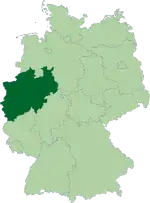Hagen
Hagen (German pronunciation: [ˈhaːɡn̩] (![]() listen)) is the 41st-largest city in Germany. The municipality is located in the state of North Rhine-Westphalia. It is located on the south eastern edge of the Ruhr area, 15 km south of Dortmund, where the rivers Lenne and Volme (met by the river Ennepe) meet the river Ruhr. As of 31 December 2010, the population was 188,529.
listen)) is the 41st-largest city in Germany. The municipality is located in the state of North Rhine-Westphalia. It is located on the south eastern edge of the Ruhr area, 15 km south of Dortmund, where the rivers Lenne and Volme (met by the river Ennepe) meet the river Ruhr. As of 31 December 2010, the population was 188,529.
Hagen | |
|---|---|
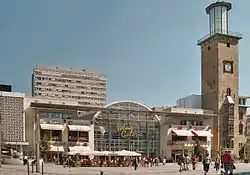 Old Town Hall (right) and Square. In the center the Volme Galerie (City Mall). | |
 Flag  Coat of arms | |
Location of Hagen 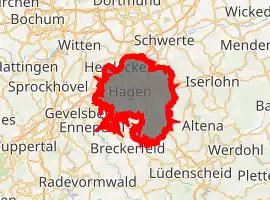
| |
 Hagen 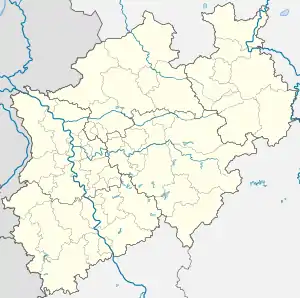 Hagen | |
| Coordinates: 51°22′N 7°29′E | |
| Country | Germany |
| State | North Rhine-Westphalia |
| Admin. region | Arnsberg |
| District | Urban districts of Germany |
| Government | |
| • Lord mayor | Erik O. Schulz (independent) |
| Area | |
| • Total | 160.4 km2 (61.9 sq mi) |
| Elevation | 106 m (348 ft) |
| Population (2019-12-31)[1] | |
| • Total | 188,686 |
| • Density | 1,200/km2 (3,000/sq mi) |
| Time zone | UTC+01:00 (CET) |
| • Summer (DST) | UTC+02:00 (CEST) |
| Postal codes | 58089–58099, 58119, 58135 |
| Dialling codes | 02331, 02334, 02337, 02304 |
| Vehicle registration | HA |
| Website | www.hagen.de |
The city is home to the FernUniversität Hagen, which is the only state-funded distance education university in Germany. Counting more than 67,000 students (March 2010), it is the largest university in Germany.[2]
History
Hagen was first mentioned around the year 1200, and is presumed to have been the name of a farm at the confluence of the Volme and the Ennepe rivers. After the conquest of Burg Volmarstein in 1324, Hagen passed to the County of Mark. In 1614 it was awarded to the Margraviate of Brandenburg, according to the Treaty of Xanten. In 1701 it became part of the Kingdom of Prussia.
After the defeat of Prussia in the Fourth Coalition, Hagen was incorporated into the Grand Duchy of Berg from 1807–13. In 1815 it became part of the new Prussian Province of Westphalia.
The city developed more rapidly in the 19th century, stimulated by industrialization: the mining of coal and the production of steel in the Ruhr Area. In reaction to the Kapp Putsch in March 1920, when rightists tried to overthrow the elected government and restore the monarchy, tens of thousands of leftist workers in the Ruhr Valley, Germany's most important industrial area, rose up in protest. They were known as the Red Ruhr Army.
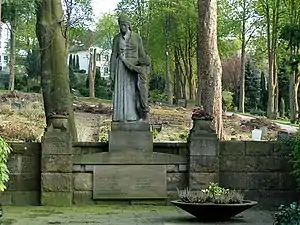
Thousands of workers went on strike and fought during the Ruhr Uprising, 13 March - 2 April 1920. Government and paramilitary forces were ordered against the workers, suppressing the uprising, and killing an estimated 1,000 workers. A memorial to the uprising was installed in Hagen.
By 1928, Hagen had developed into a city of more than 100,000 inhabitants.
During World War II, Hagen was bombed repeatedly, by both the Royal Air Force and the United States Eighth Air Force. On the night of 1 October 1943, 243 Lancasters and 8 Mosquitoes from the Royal Air Force's Bomber Command attacked the city. According to the Bomber Command Campaign Diary, "This raid was a complete success achieved on a completely cloud-covered target of small size, with only a moderate bomber effort and at trifling cost." Hagen sustained severe damage from that raid, and hundreds of civilians were killed.
After World War II, the city was included in the new state of North Rhine-Westphalia in the Federal Republic of Germany (FRG, also known as West Germany).
Economy
Owing to the extensive use of water power along the rivers Ruhr, Lenne, Volme and Ennepe, metal processing played an important role in the region of Hagen in and even before the 15th century. In the 17th and 18th centuries, textile and steel industries, as well as paper production were developed here.
In the early 21st century, Hagen is the home of the Suedwestfaelische Industrie- und Handelskammer, as well as Sparkasse Hagen, the local municipal savings bank. The bank's former headquarters, the Sparkasse Hagen tower, was a regional landmark until its demolition in 2004.
The city is heavily indebted and in the process of cutting city services in order to balance its budget.
The city has capitalized on the export of a wide variety of breads, most notably Hagenschmagenbrot, a traditional dark bread.
Education
One of the five branches of South Westphalia University of Applied Sciences is located in the city (also: Fachhochschule Südwestfalen (FH SWF)), which offers various engineering programmes. This institution was founded in the city in 1824.
Attractions
Hagen is home to the LWL-Freilichtmuseum Hagen, or Hagen Westphalian Open-Air Museum, a collection of historic industrial facilities. Trades such as printing, brewing, smithing, milling, and many others are represented, not only with static displays, but as living, working operations that visitors may in some cases participate in. It is located near the Hagen community of Eilpe.
The Historisches Centrum Hagen includes the city museum and Werdringen castle. In the Blätterhöhle cave in Hagen, the oldest fossils of modern people in Westphalia and the Ruhr were found. Some date to the early Mesolithic, 10,700 years B.C.E. It seems that the descendants of Mesolithic people in this area maintained a foraging lifestyle for more than 2000 years after the arrival of farming societies.[3]

Boroughs
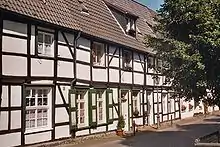
| Borough | Population Oct 2007 | Area in km² |
|---|---|---|
| Hagen-Mitte | 78.952 | 20.5 |
| Hagen-Nord | 38.451 | 29.6 |
| Hagen-Haspe | 30.360 | 22.2 |
| Hagen-Eilpe/Hagen-Dahl | 17.148 | 51.1 |
| Hagen-Hohenlimburg | 31.306 | 37.0 |
some localities of Hagen:
- Hagen-Dahl
- Hagen-Emst
- Hagen-Priorei
- Hagen-Rummenohl
- Hagen-Halden
Demographics
The following table shows the largest foreign resident groups in the city of Hagen.[4]
| Rank | Nationality | Population (31.12.2017) |
|---|---|---|
| 1 | 7,196 | |
| 2 | 3,558 | |
| 3 | 3,175 | |
| 4 | 2,534 | |
| 5 | 1,481 | |
| 6 | 1,082 | |
| 7 | 928 | |
| 8 | 876 | |
| 10 | 710 | |
| 11 | 678 | |
| 12 | 543 | |
Lord mayors
- 1946–1956: Fritz Steinhoff (SPD)
- 1956–1963: Helmut Turck (SPD)
- 1963–1964: Fritz Steinhoff (SPD)
- 1964–1971: Lothar Wrede (SPD)
- 1971–1989: Rudolf Loskand (SPD)
- 1989: Renate Löchter (SPD)
- 1989–1999: Dietmar Thieser (SPD)
- 1999–2004: Wilfried Horn (CDU)
- 2004–2009: Peter Demnitz (SPD)
- 2009–2014: Jörg Dehm (CDU)
- since 2014: Erik O. Schulz (independent)
Traffic
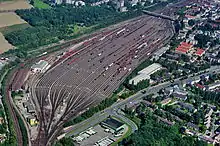
The Autobahnen A1, A45 and A46 touch Hagen.
Hagen has been an important rail junction for the southeastern Ruhr valley since the first rail line opened in 1848. The marshalling yard of Hagen-Vorhalle is among Germany's largest, and the central station offers connections to the ICE network of Deutsche Bahn as well as to local and S-Bahn services. Since December 2005, Hagen has also been the starting point for a new service into Essen, operated by Abellio Deutschland.
Local traffic is handled by Hagener Straßenbahn (Hagen Tramways), which, despite its name, offers only bus services, as the last tramway route in Hagen was abandoned in May 1976. All in all there is a large-scale network of 36 bus lines in Hagen. All local rail and bus services operate under the transport association VRR.
Sport
The German Basketball Federation (DBB) is based in Hagen
Sport clubs in Hagen:
- TSV Hagen 1860 - largest club (multiple fistball champions)
- SSV Hagen (1974 basketball champions), later known as Brandt Hagen
- Phoenix Hagen, Basketball Bundesliga - ENERVIE Arena im Sportpark Ischeland
- Hasper SV
- Hohenlimburger SV (multiple women water polo champions)
International relations
Hagen is twinned with the following towns:
|
Personalities
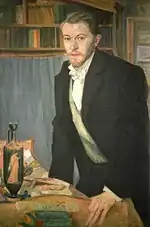
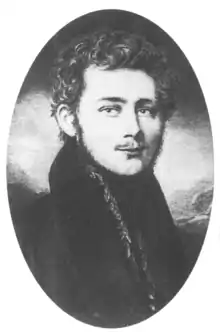
- Friedrich Harkort (1793-1880), railway and industrial pioneer and politician (German Progressive Party)
- Georg von Vincke (1811-1875), politician
- Sir Karl Halle, also known as Sir Charles Hallé (1819-1895), pianist, composer and orchestra conductor
- Eugen Richter (1838-1906), politician (German Progressive Party)
- Wilhelm Böing (born 1846 in Hagen-Hohenlimburg), father of William Boeing, founder of the Boeing aviation company.
- Karl Ernst Osthaus (1874–1921), banker and patron of avant-garde art and architecture
- Will Lammert (1892-1957), sculptor
- Hansheinrich Dransmann (1894-1964), conductor, composer
- Franz Bronstert (1895–1967), painter
- Fritz Steinhoff (1897-1969), politician (SPD)
- Heinrich Brocksieper (1898-1968), painter and photographer, experimental filmmaker and former Bauhaus student
- Hans Nieland (1900-1976), politician (NSDAP)
- Burkhart Waldecker (1902-1964), explorer
- Hugo Paul (1905-1962), politician (KPD)
- Ernst Meister (1911-1979), lyricist, radio playwright, narrator and theater author
- Emil Schumacher (1912-1999), painter (abstract art)
- Artur Axmann (1913-1996), politician (NSDAP) and Reichsjugendführer
- Herbert Reinecker (1914-2007), writer and screenwriter
- Liselotte Funcke (1918–2012), liberal politician, vice president of federal parliament, state Minister of Economy in North Rhine-Westphalia, Federal Commissioner for Foreigners
- Nicholas Rescher (1928- ), American philosopher
- Rotraut Wisskirchen (1936-2018), Biblical archaeologist
- Freddy Breck (1942-2008), percussionist
- Jürgen Schläder (1948–), musicologist
- Hans Reichel (1949-2011), guitarist, violinist, instrument maker and typographer
- Annette Humpe (1950-) music producer, singer of the bands Ideal and Ich + Ich
- Nena (Gabriele Susanne Kerner) (1960-), pop singer
- Antje Vowinckel (1964- ), sound artist, radio artist and musician.
- Mousse T. (Mustafa Gündogdu) (1966-), DJ, musician, remixer and producer
- Mambo Kurt (Rainer Limpinsel) (1967-), musician and solo entertainer
- Barbara Morgenstern (1971-), musician
- Claus Jacobi (1971-), politician (SPD), mayor of Gevelsberg
- Henning Wehn (1974-), comedian
- Jan-Ole Gerster (1978-), film director and screenwriter
- Bettina Hauert (1982-), professional golfer
- René Eidams (1989-), darts player
References
- "Bevölkerung der Gemeinden Nordrhein-Westfalens am 31. Dezember 2019" (in German). Landesbetrieb Information und Technik NRW. Retrieved 17 June 2020.
- "Archived copy". Archived from the original on 2010-11-23. Retrieved 2010-10-12.CS1 maint: archived copy as title (link)
- "2000 Years of Parallel Societies in Stone Age Central Europe." Ruth Bollongino, Olaf Nehlich, Michael P. Richards, Jörg Orschiedt, Mark G. Thomas, Christian Sell, Zuzana Fajkošová, Adam Powell, Joachim Burger. Science. Published Online October 10, 2013. DOI: 10.1126/science.1245049 http://www.sciencemag.org/content/early/2013/10/09/science.1245049
- "Statistisches Jahrbuch 2013". Westfalenpost. Retrieved 2016-04-23.
External links
| Wikimedia Commons has media related to Hagen. |
 Hagen travel guide from Wikivoyage
Hagen travel guide from Wikivoyage- Official website
 (in German)
(in German) - . Encyclopædia Britannica (11th ed.). 1911.

